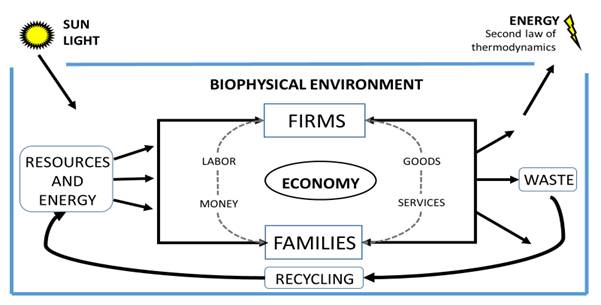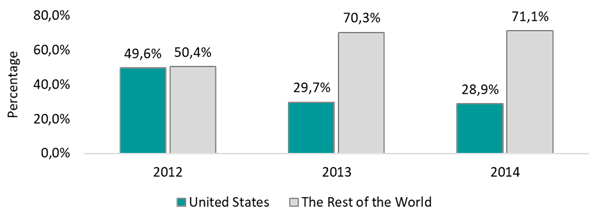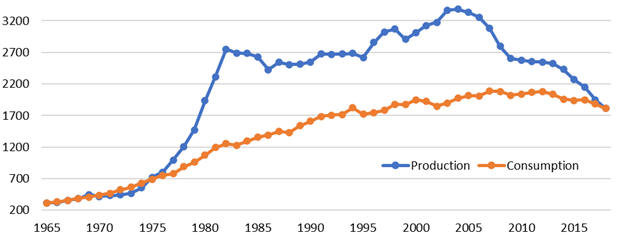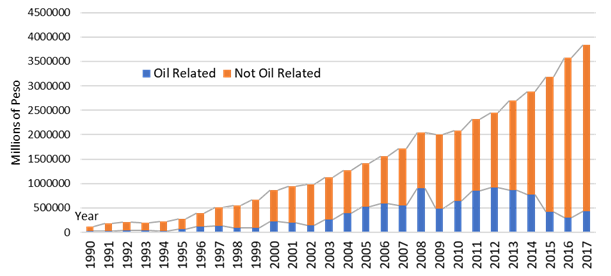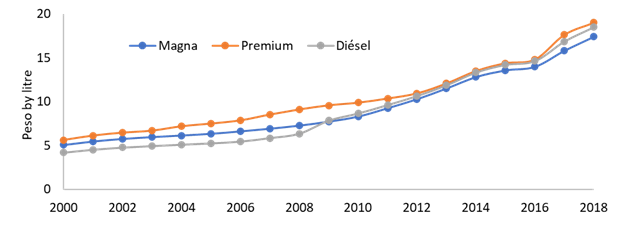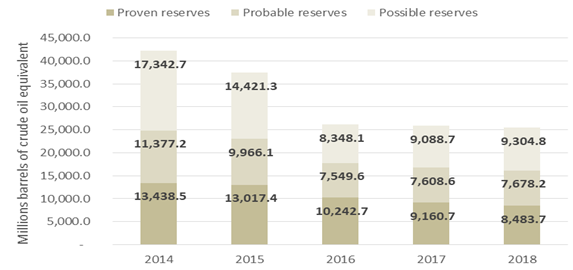Introduction
The research discusses the need for a review of Mexico's development strategy based on the analysis of the situation of oil reserves. This is relevant given the role that the sector has had in Mexican economic policy in recent decades and due to the prospects for the new political situation in the country.
The foregoing is proposed through the explanation of the importance of energy and in particular of oil for the evolution of human society and in the performance of the market economy. In the case of Mexico, the paper focuses on the conditions offered by oil reserves and the capacity of the oil sector for their exploitation.
The evidence provided in the article is intended to present a reasonable criticism of the official development strategy based on oil exploitation. Nevertheless, it is clear that the response to the challenges presented by a society like the Mexican society cannot be based on the abandonment of the oil sector or on the development of alternative technologies, but on the rethinking of the development objectives in harmony with energy reserves.
In the first section, we discuss the theoretical foundation of a biophysically based heterodox economic theory approach for the study of the role of energy in modern society and its particularities in Latin American socio environmental thought. The second section focuses on the importance of energy for the understanding of social development. Finally, in the third part, we analyze the evolution of the Mexican economy based on the abundance of cheap oil and the new legal context of the energy constitutional reform of 2014 enforced as a result of the context of scarcity.
Having developed the theoretical framework, we set out to demonstrate, how the economic model implemented Mexico from the 1980s was articulated around the abundance of cheap oil. The resources obtained from the oil wealth were not only used to adapt the productive apparatus to the interests of the foreign capital, but also to shape and empower a new social subject formed by the alliance of criminal groups, businessmen and government officials.
Empirical evidence on the social and environmental impacts of this transition, and on the change in the specific weight of the oil sector in the economy from the exhaustion of reserves, are addressed in the graphs and time series.
With the end of access to cheap oil, the economic foundation of the open economy collapsed, and a new development scheme is now implemented.
Theoretical foundations: The metaphysics of energy resources economics
The most relevant contribution of ecological economics to the theoretical corpus of economic science is the fundamental approach that productive activity is functionally interconnected with the exploitation of natural resources. Where conventional economic theory lays its theoretical-empirical corpus, the natural world on which it depends, ecological economics builds its object of study through the concept of social metabolism and the interdependence of economic laws with the laws that govern nature.
The foregoing is raised as follows by one of the fathers of the ecological economy:
Economic science studies the economy, that is, the prices and quantities exchanged in markets (a study that Aristotle called "crematistics" in The Politics), and the aggregate magnitudes of macroeconomic accounting. This economy cannot be understood as a self-sufficient system. The economy is necessarily open to the entry of energy and materials and the exit of waste and dissipated heat. The economy must be seen from the point of view of socio-economic metabolism. (Martínez, & Roca, 2013).
The divorce of mainstream economic theory from the consideration of the laws of nature has led to the establishment of an understanding of economics that prioritize economic efficiency principles over the ecological imperatives.
In a world of scarcity and pollution, the functional approaches of traditional economic theory, which consider natural resources as goods whose disposition depends only on the laws of the market, cannot be applied at the risk of jeopardize conditions conducive to life.
Epistemological roots of neoclassical and biophysical based heterodox economic theories
Metaphysics is the methodological foundation of mainstream economics. The discipline is based upon a logic system that considers the validity of ideas aprioristically, beyond any empirical evidence (Martínez, 2013; Vélez, 2016).
Economics, as it is taught in the most important universities around the globe, sets a group of fixed axioms, that constitute the main theoretical framework upon which most economic instruments and policies are built. Abstract concepts like general equilibrium, or homo economicus, or natural capital establish the “scientific” framework of the discipline. Therefore, economic policy is based more on beliefs than in scientific empirical facts. From this perspective, mainstream economic theory can be interpreted more as an ideology than a product of sound science (Ackerman, Nadal & Gallagher, 2004).
Under this view, nature becomes an innocuous concept. It is considered a resource for economic activity or a space for waste disposal ruled by the laws of the economy. Environmental collapse, the depletion of most natural resources and the acceleration rate of pollution of world ecosystems have opened a wide range of criticism to this body of theory.
As Sverdurp explains, the depletion of most natural resources is at the base of the main limitation of the “efficiency approach” of conventional economics:
The peak production rate phenomenon (best known is “peak oil”) has been shown to be applicable to natural resources such as phosphorus, minerals or metals but also to other aspects of society including national economies [1-13]. Peak resources imply that the resource production considered goes through a maximum and then production declines to insignificance over time as the reservoir is depleted. This common production behavior is a practical tool for evaluation of finite resources that are being exploited at present. We have come to a period in human history where we may catch glimpses of what may constitute the sunset of modern technological civilization as we know it, unless significant changes to present behavior and national and global policies are made within the next four decades [14-21]” (Sverdrup, Koca, & Ragnarsdóttir, 2013, p.189)
In reaction to peak resources, researchers from different disciplines have developed a set of approaches, a group of theories that, despite their differences, coincide in the need for a new understanding of the relation between society and nature, and in the role of modern economies in their interaction.
The main difference between mainstream economics and biophysically based heterodox approaches lies in the idea that the economy is a subsystem embedded in a greater system: the biophysical world as shown in figure No. 1 (Costanza, Cumberland, Daly, Goodland, & Norgaard, 1997; Martínez, & Roca, 2013; Hall and Klitgaard, 2012).
The main conflict of mainstream economics theories rests on the idea of perpetual growth. For the biophysically based heterodox economics theory, infinite growth is not possible in a finite world (D’Alisa, Demaría, & Kallis, 2015). Therefore, ecological economics and biophysical economics give a different interpretation of the current ecological collapse. They consider the imperative of rethinking social production and consumption patterns (Martínez, 2009).
The generalized, permanent and accelerated deterioration of the quality of each and every one of the life support systems in the planet irrefutably demonstrates the inability of the dominant theoretical body of economic science to explain the problem and, consequently, to offer solutions. Therefore a new economic theory is needed, one that centers the attention not only in social metabolism (ecological economics), but in new ways of social organization, consumption and production (solidarity economics), in the study of environmental conflicts (political ecology), and in the moral aspects of social production (bioethics) and other disciplines. The main task of these theories is to open the scope of traditional economics to a wider set of problems related to the dynamics of the ecological situation, to a space of economic interpretation of the biophysical world in its relation with market mechanisms.
Ecological Economics, Biophysical Economics and the Latin American approaches: the new synthesis.
The biophysically based heterodox economics theories include ecological economics, biophysical economics, Latin American Political Ecology and other currents. The epistemological identity of the new theoretical approach finds its roots in the critique of traditional economics, its field of research and its methodology. Nevertheless, there are significant differences between the conceptual frameworks of the theoretical currents. The debate is focused in part on the need or usefulness of some instruments and concepts of traditional economic theory for the study of socio environmental issues. Given the neoclassical roots of the Ecological Economics movement and the traditional academic origin of its main representatives, Roegen and Daly, some contemporary western ecological economists tend to ignore the methodological and conceptual differences between the two schools, and develop research that can be identified as the standard approach of neoclassical economics such as Environmental Economics or Economics of Natural Resources (Daly, & Farley, 2003).
In 1999, Costanza, cofounder of the International Society for Ecological Economics, published a seminal paper about ecosystem services valuation and opened an intense academic discussion on whether valuation of nature contributes to overexploitation or to conservation. The piece “The value of the world´s ecosystem services and natural capital”, also gave the opportunity to develop a new area of research related to the mapping and valuation of different biomes of the world. Costanza and his colleagues argue that knowledge of the market price “of what nature gives humanity for free” might generate the need for conservation because governments would realize the real market cost of ecological services such as pollination, the treatment for diseases related to environmental degradation or the recharge of aquifers.
Because ecosystem services are not fully ‘captured’ in commercial markets or adequately quantified in terms comparable with economic services and manufactured capital, they are often given too little weight in policy decisions. This neglect may ultimately compromise the sustainability of humans in the biosphere. The economies of the Earth would grind to a halt without the services of ecological life-support systems, so in one sense their total value to the economy is infinite. However, it can be instructive to estimate the ‘incremental’ or ‘marginal’ value of ecosystem services (the estimated rate of change of value compared with changes in ecosystem services from their current levels). (Costanza et al, 1997, p. 253).
Biophysical Economics has a different approach. In a nutshell, the biophysical economists´ critique of ecological economics is that it does not center its attention in the most important aspect of social metabolism, i.e. the biophysical foundation of all wealth generated by society.
It is essential that economics be based on sound principles and that the policies generated from it have a solid foundation. Neoclassical Economics, the form of economics derived in the mid- 19th century that prevails today, focuses on problems related to value decisions, the behavior of economic actors, and the working of markets. These problems belong to the sphere of the social sciences (many of which, incidentally, have their own problems with neoclassical economic theory; see, for example, Marris 1992). But the wealth that is distributed in the markets must be produced in the hard sphere of the material world where all operations must obey the laws and principles of physics, chemistry, and biology. Our concern is that most production models of economics are not based on these biophysical laws and principles; in fact, they tend to ignore them (Roegen, 1971; Daly, 1973, 1977; Kummel et al., 1985; Leontief, 1982; Cleveland et al., 1984; Hall et al., 1986, 2001, p.663; Hall, 1992; 2000). (Hall et al, 2001, p. 663).
Basically, the theoretical controversy between the two main schools of biophysical based heterodox economics, ecological economics and biophysical economics, can be summarized as where the emphasis should be established: Is it environmental governance or is it the biophysical support of production?
The theoretical debates of the last few years between ecological economists and biophysical economists express the theoretical differences between the two schools. While ecological economists have focused on issues such as the valuation of ecosystem services or the impacts of macroeconomic policy on the environment (issues related to the functioning of the economy), biophysical economists have focused on issues such as peaks of Hubert in the exploitation of natural resources or in the returns of energy from investments (aspects related to the overexploitation of natural resources and demographic exploitation).
Together with these two theoretical proposals, there is a third important branch of biophysical based heterodox economics: The Latin American approach. Latin Americans theoreticians (Barkin, 1998; Acosta & Brand, 2017; Pengue, 2016; Martínez & Roca, 2013) emphasize the social and geopolitical conditions of the ecological crisis. They have analyzed themes like the ecological debt of the first world, the ecological distribution of conflicts and the socio-cultural alternatives to the current model.
As Barkin points out, Latin American school of ecological economics concentrates on the particularities of the region’s social conditions and history and on the need to focus on development problems:
The critical version warns about the role of economic rationality in unsustainability. Its origins come from the Latin American region of the ISEE where they insist that the implementation of market instruments alone does not promote a solution to the environmental crisis; they point out that their inadequate incorporation of a methodological pluralism can deepen the socio-environmental crisis. It is enriched with the contributions of political ecology, incorporating two fundamental and critical concepts to the role of capitalist economic rationality: a) monetary immeasurability as a priority language in the valuation of nature; and b) the concept of distributive ecological conflicts, highlighted within an environmentalism of the poor and that of environmental justice. (Barkin, Fuente, & Tagle, 2012, p. 4).
Latin American ecologism has long historic roots. Although indirectly, Latin American environmental thought is linked to the revolutionary ideals of freedom against the oppression of Western colonizers and the destruction that the conquest and neocolonial policies left behind. In the libertarian struggles of Latin America, we find demands on the right of the inhabitants to control the resources of their communities and on the rejection of environmental destruction. That is the origin of Tupac Amaruc fight cry "We do not want them to take the honey from our honeycombs" in the Peruvian struggle for independence or Emiliano Zapata's "Land and freedom" in the Mexican Revolution. From this historical perspective, the social and liberation struggles embodied the demands that centuries later constituted the theoretical foundations of Latin American environmental intellectuals.
Leff, describes the most important intellectual particular sources of Latin American environmentalism:
Among the strands of environmentalism that have influenced Latin American environmentalism, we must highlight the thought of complexity (Edgar Morin), deep ecology (Arne Naess), ecoanarchism (Murray Bookchin), ecomarxism (James O'Connor), ecological economics and political ecology (Joan Martínez Alier, Clóvis Cavalcanti, Arturo Escobar and Carlos Walter Porto Gonçalves) .6 At the same time, we must recognize our own theoretical veins that have had their sources of creativity and applications practices in Latin American territories, among which are the methodology of interdisciplinary research on the theories of complex systems by Rolando García (2006); the autopoiesis of Francisco Varela and Humberto Maturana, who in the field of cognitive science has inspired the environmentalist ethic of various Latin American authors; the development on a human scale of Manfred Max-Neef, Antonio Elizalde and Martin Hopenhayn; the social ecology developed by Eduardo Gudynas and Alberto Acosta; the foundation of a Latin American environmental history (Castro, 1996); and the development of a methodology for the application of accounts of the environmental heritage of Latin America (Sejenovich and Gallo Mendoza, 1996). The concept of environment as potential is a truly Latin American contribution. From there arises the proposal of a new productive paradigm based on ecological-technological-cultural productivity - of an economy based on negentropic productivity - as the basis of sustainability of an environmental rationality. (Leff, 2017, p. 154).
Given the fact that there is great influence coming from the Western intellectual tradition in the Latin American environmentalist theoretical movement, regional environmentalism has tried to find its own identity by providing a different interpretation to some of the most important European and North American visions. The influence of Western ideas on Latin American intellectuals brought to the attention of epistemologists such as Boaventura de Sousa the idea of the need of the decolonization of the mind (De Sousa, 2010). According to this idea, not only mainstream, but also most critical social science theoretical currents have been absorbed and by this way a westernized socio-environmental agenda has been imposed in academia and research institutions, and agenda that has systematically ignored the priorities of local, indigenous and the overall popular Latin-American communities.
Consequently, it can be expected that a new economic theory, the economics of human ecology, will be born from a synthesis, a new re-conceptualization of the relation between the ecological, economic and social imperatives in each regional context. It is clear that biophysical phenomena do not appear in a social vacuum or outside market structures and policies. This is why, the new approach faces a great challenge: the need to overcome the temptation of determinism and to advance to a new stage of theoretical interpretation of the complex, interrelated, uncertain and non - hierarchic reality.
The new theoretical interpretation of a bioeconomic reality (a term coined by one of the fathers of ecological economics, N.G. Roegen) must start from the idea that economies in any spatial reference framework must be seen as ecosystems...
With their own structures and functions, their own flows of materials and of energy, with more or less diversity and stability and so on: in short with all the characteristics of natural systems, with, generally, much greater energy intensity and dominance by one species. (Hall & Klitgaard, 2012, p. 95).
And just as in the communities of living beings, each individual...
finds itself in a relentless situation where it has been selected to increase its energy gains and decrease its energy costs, for its ability to pass on its genes is possible only if it has managed to acquire a large net energy balance. (Hall &Klitgaard, 2012, p. 95)
From this perspective, Roegen affirmed that thermodynamics (and in particular, its measurement: entropy), is the "economy of nature" since it expresses, in terms of the imperative of the continuity of life, the criteria of efficiency in energy use (Georgescu-Roegen, 1996). The competition of the species or of the individuals is nothing other than the struggle for the survival of the gene carrier with a reduced entropy metabolic regime, whether on an individual, community or whole species scale. As Dawkins affirms, in the fight for survival, what is at stake is not the preservation of the individual or of a certain species, but the living being with the most efficient way of conserving life (Deoxyribonucleic Acid, DNA) through energy conductors (Adenosine Triphosphate, ATP) at the cellular level. Its carrier, be it a mammal or a bacterium, will be “selected” to continue to exist preserving life in earth (Dawkins, 1990).
On a social scale, animal communities also differ from each other according to efficiency in energy consumption patterns. In general, more entropic societies are more vulnerable because they reduce their resilience due to increased risk and dependence on energy sources: the less entropic the social metabolism of a community, the greater its opportunities to remain in competition for survival. Today, we observe that human society has evolved thanks to the construction of a highly entropic technological and productive scheme, of great waste of dissipated energy, which has put its continuity at risk.
This is, in essence, the fundamental function and essential link of energy to life. Understanding this inseparable relationship, the two sides of the coin of existence, is a necessary condition to understand the scope and limits of the emergence of the new theoretical paradigm that responds to the great challenges posed by the search for sustainability.
Energy and biophysical economics
The Universe began its existence with the Big Bang´s energy flows approximately 14 000 million years ago, and matter appeared from pure energy after one millionth of a second after the great explosion.
Only in the first seconds of a hot Big Bang, with an initial abundance of protons and neutrons that would result in something very close to the observed density of matter in visible galaxies today, and a density of radiation that would leave a remnant that would correspond precisely to the observed intensity of the cosmic microwave background radiation today, would nuclear reactions occur that could produce precisely the abundance of light elements, hydrogen and deuterium, helium and lithium, that we infer to have comprised the basic building blocks of the stars that now fill the night sky. (Krauss, 2012, p. 121).
Some 4 540 million years ago, the Earth was formed from matter created from the Big Bang and since then, the energy flows sent from the Sun have had a decisive influence in the appearance of life on the planet approximately 4 billion years ago.
Life on planet Earth cannot be explained without permanent energy flows. The appearance of the primitive pre-DNA components used the driver of energy flows to evolve to DNA, the essential characteristic of all life forms. Consequently, the first living microorganisms appeared and, with time and energy, they evolved into multicellular beings. The first living forms fed directly on energy synthesized out of complex chemical compounds. As a result of chemical reactions related to the appearance of more advanced life forms (stromatolites), the original nature of the primitive atmosphere changed to an oxygen-based environment, which led to the omnipresence of aerobic organisms. Energy has been, since the beginning of life, the source of growth for living organisms, either in the form of direct appropriation from radiation in the beginning of life or indirectly through the consumption of biomass in the oxygen based atmosphere.
Thus, the functional unity between life and energy has been expressed in a continuous process with evolutionary stages since the geological origins of the planet: “life can no longer originate and develop thanks to a process of purely chemical evolution. For a simple fact, the forms of energy that made it arise initially - the energy of ultraviolet radiation and radioactivity has virtually ceased”. (Asimov, 1982, p. 585).
Energy is the most important factor in the development of human society. We know that Homo sapiens appeared in Africa some 350 thousand years ago and its development depended on the use of energy, first through the appropriation of living sources of energy directly from nature - as all the rest of the animal kingdom- and later on, through the domestication of fire.
At what moment could we say that the precursors of man become the man himself? This is a sensitive issue, because such changes do not happen overnight. It would be awkward to try to make them appear as more sudden than they really were, to set the transition too accurately or to argue about the names. Two million years ago we weren't men yet. A million years ago we already were, because at the time there appears a creature that can be called Homo, Homo erectus, which spreads beyond Africa. The classic finding of Homo erectus occurred in fact in China. He is the man from Beijing, dating back to four hundred thousand years, and who is the first creature that certainly used fire. (Bronowski, 2017, pp. 18-19).
In primitive societies the fine equilibrium of natural systems that allowed the development of life was not at stake. Human primitive societies depended on biophysical flows and material stocks, but modern society modified the basic biophysical equilibria that allowed the existence of life.
The tipping point in this process was the Industrial Revolution. From an energetic point of view, it consisted of the incorporation of a highly efficient source of energy, fossil fuels, into social production processes. Society found a way to externalize the work formerly executed by humans to a substance that allowed people to save time and consequently improve their standard of life, their material well being, their heath and nutrition. The massive exploitation of fossil fuels generated by the Industrial Revolution, triggered by the development of industrial technology, meant the acceleration of natural energy cycles, i.e. the relocation of carbon - generated in the carboniferous geologic period approximately 359 million years ago- to the atmosphere. As a result, the atmosphere changed its chemical structure and climate patterns. In a relatively short period of time according to the Earth`s geologic clock (less than a hundred years), human society released great amounts of fossil fuel (encapsulated photosynthesis) and by doing this, altered dramatically the natural cycle of matter and energy, a system generated over millions of years (Martínez, 2015).
The energy approach of the biophysical based heterodox economic theory considers the imperative to include in the analysis of the production process the limitations imposed by the Universal laws of thermodynamics, and entropy. Knowing and respecting the laws that govern energy and its flows and transformations is essential to preserve the biophysical balances that allow life on the planet. Thermodynamics explains that in the Universe the work generated by any source of energy always increases the level of entropy, chaos or wasted energy. The universal thermal balance at the end of History is the inescapable destiny of everything that exists.
As Roegen explains it…
To the elementary truth that matter-energy cannot be created or destroyed, thermodynamics adds that matter-energy is continuously degrading from an available to an unavailable form, regardless of whether life is present or not and, therefore, regardless of whether we use it to get a job or not. This is the fifth essence of that law that has the formidable name of the entropy law, about which we will hear more and more frequently (if we pay attention to the inclination that follows the literature). The law simply says that entropy, understood as a relative index of energy not available in an isolated system, is constantly increasing. (Roegen, 1994, p. 192).
To ignore the laws of thermodynamics in the process of production means to accelerate the level of entropy and chaos, it means to destroy the biological order or life, condition of order that by itself is, according to (Schrödinger, 2005), a contradiction to the second law of Thermodynamics.
The current ecological collapse, in particular the climate crisis, is caused mainly by the intrinsic nature of our production system and technology that has created a highly entropic social metabolism, a waste oriented society. The technology and systems of production have created a new environment characterized by an excess of energy waste.
The excess of energy use in industrial society has had great parallel consequences. It allowed mass production and the acceleration of consumption of natural resources. This phenomenon, known as “The Great Acceleration” in biophysical economics, is at the root of the current environmental collapse that expresses itself basically in the current social and economic disruptions. We argue that the scarcity of nature´s raw materials explains the degradation of the social fabric and creates a vicious circle of predatory behavior over the remaining stocks of natural resources, war, migration and conflict.
Mexico: energy transition to where?
From the Mexican Miracle to the open economy
Until the 80’s, the Mexican economy was considered an economic miracle. It was a closed system with significant trade tariffs protection. The economy was oriented to the development of local markets detached from foreign flows and export activity was concentrated in the oil industry. Petroleum extraction and sales in oil related markets played a key role in the golden age of Mexican economy from 1952 to 1970. The petroleum industry development was at the basis of high consumption standards and of the relatively high and stable economic growth rates. The proportion of oil related revenues in the federal budget reached 40%. With the resources provided by oil extraction, the government promoted the growth of productive urban infrastructure. Cheap oil was at the basis of the “Mexican Miracle” (Ezquivel, 2010, p. 38).
Nevertheless, during the de la Madrid administration the Mexican miracle model reached its limits. As a result, state participation was severely reduced, and the economy was reoriented to the foreign sector. In 1994, the North American Free trade Agreement (NAFTA) was signed.
After more than two decades of formal North American trade integration, the Mexican economy became an appendage of the American economy and the national economy was been dismantled. With NAFTA, due to the lack of competitiveness, traditional Mexican companies practically disappeared. In 2015 less than 1% of companies participated in foreign trade, and 68% of total exports were concentrated in 1% of the leading exporting companies, most of them North American transnational corporations (Park, Urmeneta, & Mulder, 2019).
Figures 2 and 3 show the degree of concentration of the Mexican external sector with respect to the United States economy.
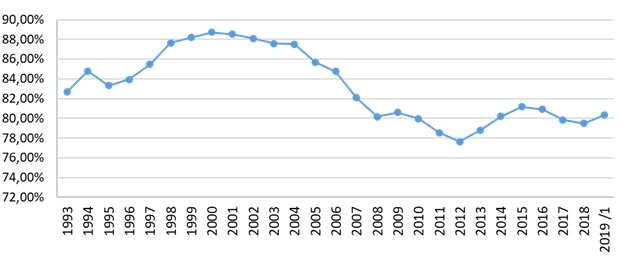
Figure 2 Percentage of Exports to the United States of the total Exports of México. Source: Banco de México (2019) /1 First trimester
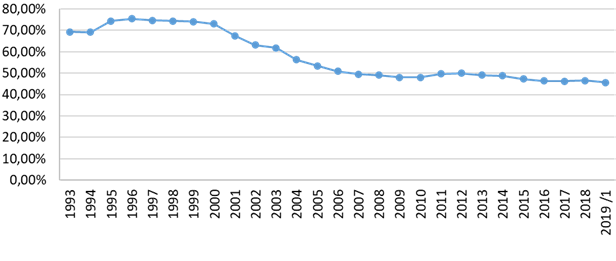
Figure 3 Percentage of Imports from the United States of the total Imports of México. Source: Banco de México (2019) /1 First trimester.
As a result of the new economic policy oriented to the external market, the Mexican economy has diversified, and the share of US foreign trade and investment has decreased. Furthermore, the country has experienced an increase in industrial exports. However, external sales are mostly made by foreign companies and the profits are also exported. Most of the productive investment also come from the US. The Mexican economy has become a space where transnational companies produce to export to American markets mainly automobiles, home appliances, aerospace technology and agricultural commodities (De la Mora, 2015). Figure 4 describes the origin of foreign direct investment in Mexico.
The State as promoter of the mafia businesses
Perhaps the most serious effect of the new economic policy in Mexico was the dismantling of the instruments of control of the economy. This opened the door for the consolidation of a new political mafia. The state was turned into an instrument for the promotion of corrupt businesses. In the new functioning of the economy, the difference between the mafia, the government and private initiative was blurred. The recent imprisonments of former governors, public officials and businessmen for their links to drug trafficking demonstrate the power structure of recent Mexican administrations (López, 2019).
Buscaglia describes the formation of the new political elite in relation with the drug lords:
Business actors in their structure, in addition to their logistic and armed operational personnel -dedicated both to the logistics of the production and marketing of their illegal products and to armed protection and money laundering -They manifest themselves through dozens of complex crimes, some of them registered in countries with an advanced rule of law, including trafficking in persons, smuggling of migrants and refugees, the arms and drug trade and, in the last phase, the laundering of resources of illegal origin. Today, drug trafficking continues to be considered the main source of illegal resources worldwide for these criminal organizations. The story that concerns us here is the last part of the cycle, how all the resources generated by the most diverse crimes mentioned above are integrated into the formal economy in the countries with the most advanced political and judicial systems. (Buscaglia, 2015, pp. 13-14).
The conversion of the state into the mafia business committee allowed the consolidation of enormous fortunes and the increase of inequality in the distribution of income. Illegal business carried out under the auspices of the government included the corrupt agreements with oil companies like Odebrecht and the appropriation of the resources of the oil rent (Sin Embargo, 2018).
The great monetary revenues obtained from oil extraction did not translate into the improvement of the conditions of the population nor into the strengthening of productive infrastructure but into the consolidation of the greatest fortunes of Mexican modern history. In recent years, the oil elites have managed to obtain greater shares of national wealth. The result has been the massive impoverishment of the majority of the population, as shown in figure 5.
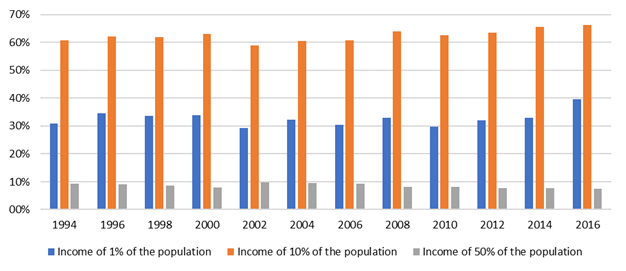
Figure 5 Adjusted national income (includes retirement and scholarships), 1994-2016. Source: Del Castillo (2019).
The 2020 oil industry: salvation table or the last nail in the coffin.
In 2019, with the decline of oil reserves and extraction and the dismantling of the nation’s productive structure created by the opening of the economy, the Mexican economy is at great risk of future collapse. Given the degree of dependency of Mexican economy to the American economy, the current US international and internal policy reform will have decisive impacts. The protectionism, the acceleration of the public debt, the demographic transition, the migration trends and other US socioeconomic realities leave Mexico with great uncertainty.
The realistic plan of development of the energy sector is one of the most important conditions for the viability of Mexican society. With the end of cheap oil, it is necessary to face the enormous socio-environmental challenges of the country in the new century.
In past, the national petrol company, PEMEX, was the most important contributor to governmental development programs. According to Caballero y Tello (2008), the oil company provided 60% of its profits to the federal budget (5,7 % of the GNP). With the depletion of oil reserves, the situation changed dramatically. Basically, the new legal framework, established in the energy reform of 2014, acknowledges the growing scarcity of cheap oil. Figure 6 shows the increase in the relative scarcity of oil in Mexico.
In recent years, oil extraction was reduced, so were its governmental revenues. The national financial hole created by reduction of oil revenues is now filled with a new taxation structure, including taxes gasoline. The rise of gasoline prices is caused basically by a special tax created in the 2014 fiscal reform. Figure 7 shows the decrease in the share of oil activity in tax revenues and figure 8 illustrates the evolution of hydrocarbon prices.
Nevertheless, reduction of the oil revenues is not the main cause of the lack of financial resources for development. The budgetary deficit of the Mexican government has its origins in the bailing out of Mexican banking system, the FOBAPROA, carried out in 1990. Currently, the amount of resources used in the public debt service reaches 29,5 % of the federal budget (Villanueva, 2018).
The decrease of the revenues from oil production and exports caused great pressures over the federal budget. To maintain the system functioning the past governments engaged in the highest debt in Mexico´s history, $200 Billion US dollars or 18% of GNP preventing the system to collapse (García, 2018).
Facing this reality in the constitutional Energy Reform of 2014, the participation of private and foreign investment in exploration, extraction and sales in the nationalized energy sector was allowed.
With the reform, the exploitation of deep water reserves in the Gulf of Mexico and the development of the fracking oil industry were meant to counter decreases in oil production created by the exhaustion of traditional wells. According to Gutiérrez (2014), of Mexico´s remaining stock of crude oil, only 24% is in conventional reserves, 23,2% is in deep water wells and 52,4% in shale oil.
In this context, in 2019 the López Obrador government started a new energy policy. The main difference with the former approach is the aim to recover the state oil company, PEMEX, from bankruptcy. If, for the former government, PEMEX’s role as the main factor of development was over, for the new administration, the national energy sector not only can be revived but can be reestablished as the main economic engine for development and social progress.
The strategy to recover the energy sector is based on three main actions: the fight against corruption, the implementation of a program to reduce the company’s financial debt and an aggressive program of investment and modernization of national refineries. The private sector will continue acting as a collateral factor of development, as a force for efficiency in permanent competition with the state enterprises, but the fracking technology option has been canceled.
It has been stated that the main objective of the new administration is to regain control over oil production and become self-sufficient in oil and gasoline supply for domestic demand. Nevertheless, according to official sources, the proven oil reserves will last only for 34.8 years, if no new reserves are found and if the planned daily extraction is to reach 2 million barrels per day.
Mexican society is in a crucial moment. On the one hand, the new government has started the implementation of a nationalistic policy with strong opposition of conservative forces within the country. On the other, the relation with the US is unstable given permanent risks of aggressions of the Trump administration against the Mexican government.
The new government's development strategy is based on the idea of re-founding the Mexican state. Inspired by the economic philosophy of economists like Krugman, Stiglitz or Piketti, the new government has bet on the Keynesian idea of activating the internal market through income distribution. In contrast to the neoclassical theory of favoring "supply" (the business sector), for the generation of employment, the new government has set itself the objective of reversing the historical inertias of the concentration of wealth. For this reason, public policy has focused on redirecting spending towards the poorest sectors of the population through direct assistance, through the application of economic support programs with a social focus. The resources for this have been obtained through measures aimed at eradicating corruption, saving in the federal government and in fiscal discipline.
However, the government has met with strong opposition from groups that, from their spaces of power, have lost their privileges. Such is the case in state and municipal governments, in the offices of the legislative and judicial powers, and in others it is all areas of public life. The transformation of the state machinery, having ceased to serve the interests of entrenched groups in power and in many cases, collusion with organized crime, has generated extraordinary social activism and political confrontation on many fronts.
On the other hand, the government is facing an unprecedented situation regarding diplomatic relations with its most important economic partner, the United States, on which the success of its transformation strategy largely depends. The President Trump administration has used sensitive bilateral issues such as illegal migration or drug trafficking as internal political factors.
Given the situation described, and the failure to apply traditional socio-economic development recipes for poor and dependent countries, it seems prudent to think of a different and advanced development strategy, a vision that is based on the evaluation of socio-environmental assets. and in harmonizing ecological imperatives with social and economic ones. It appears necessary, to establish a new era of social and economic development, to establish a realistic energy budget that takes into account the real biophysical limits of growth.
The alternative economic policy has to make an effort to reconcile national biophysical assets with the needs of development of the country through technological change and the transformation of consumption and production patterns.
Conclusion
Conventional economic theory, based on the assumption of infinite growth and infinite access to natural resources is not capable of realistically addressing the problems faced by most societies in the current situation of social crisis and degradation of production schemes and environmental conditions.
Accordingly, the complex situation that Mexico faces regarding the country's challenges of social and economic development, require a new approach. Energy, as human society history shows, is at the base of any strategy of economic growth. But Mexico, and the world, face an era of the end of cheap oil in which social, economic and environmental imperatives must be reassessed.
For Mexico, and for most countries in the world, this means the need to match the existing reserves of oil with the strategies of economic growth and to analyze the alternatives in consideration with the limitations of technological change, demographic consumption patterns.
Conventional economic theory has demonstrated its inability to explain the challenges derived from the new economic, social and, above all, environmental situation facing society. This is demonstrated by the socio-environmental collapse and the ineffectiveness of the traditional strategies that are applied to face it.
There are numerous streams of social and economic thought that have addressed the need to broaden the theoretical and methodological horizons of the human sciences. Such is the case of biophysical economics and ecological economics, which have raised, for decades, the need to reconcile ecological imperatives with social and economic ones in a way that provides solutions to current civilizational problems.
These currents have raised the need to incorporate an integral, holistic and transdisciplinary vision for tackling socio-environmental problems. In particular, heterodox schools based on the biophysical vision consider the need to integrate biophysical and ecological knowledge with economic rationality, with the understanding that the economic sphere is a subsystem of the natural sphere and not vice versa, as has been stated. in the neoclassical paradigm of economics. The traditional view of economic theory, which corresponded to a context of abundance of natural resources and limited human population, has been questioned by heterodox schools due to recent changes related to pollution and scarcity of natural resources, and overpopulation and overconsumption.
In particular, biophysical economics has raised the need to recognize the role that the exploitation of fossil energy has played in the construction of modern industrial society and incorporate the study of its determinants into economic theory, understood as the science that faces to the problems of production, distribution and consumption. The foregoing, with the understanding that fossil fuels are the main source of energy in the present and foreseeable future, and that it is a non-renewable resource whose massive and accelerated combustion is the cause of atmospheric pollution and transformation of the chemistry of the atmosphere that entails global warming, the solution to the problem of restructuring the social productive scheme towards a future different from the extinction of civilization, as we know it, depends on a new way of relating society human with the energy sources it needs for its existence, as it has happened at all stages of the history of human society.
In this sense, we have considered that the Mexican conjuncture faces an interesting opportunity to transform its economic and political system. This is the strategy of re-founding the state by the new government that could open spaces for the application of a new development philosophy based on the valuation of energy stocks and flows and the calculation of entropy levels for a biophysical model economic development. However, the task of building a development program with these characteristics is beyond the scope of the study presented.














